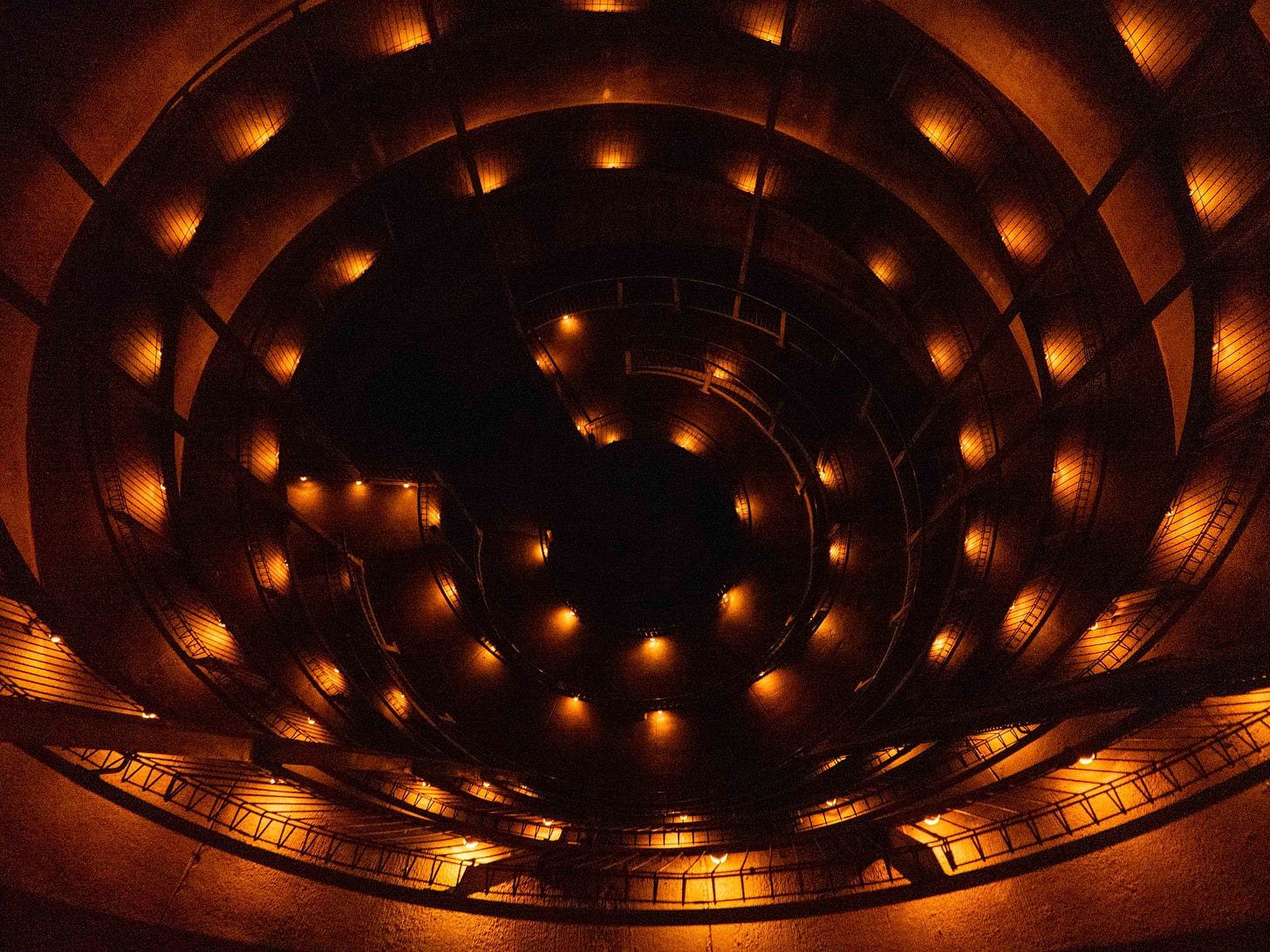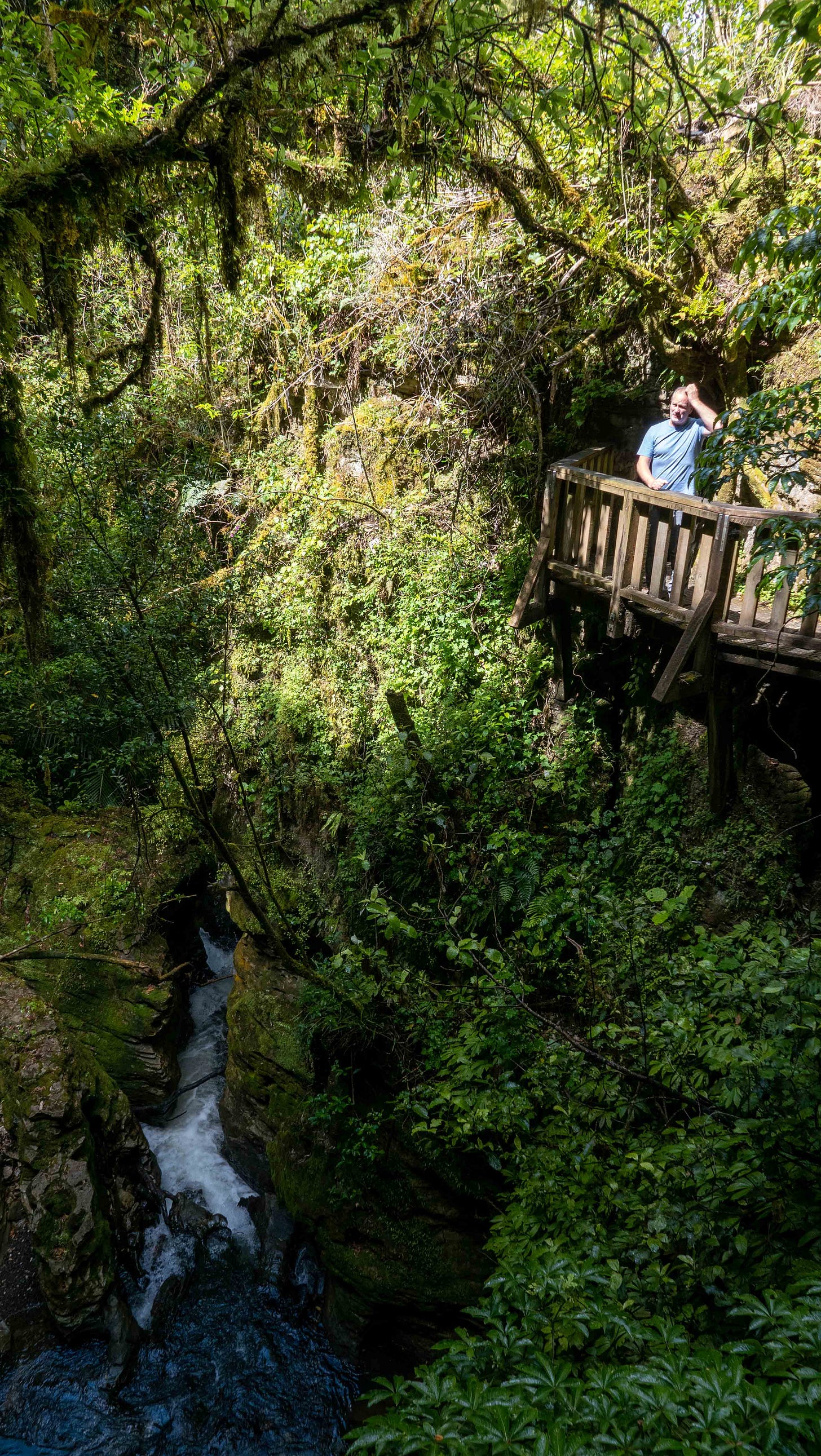Having already seen glow worms in action in the Lower Kaimai forests, I was concerned that we might have wasted our money booking trips down three of the caves at Waitomo. After all, what more were we going to see?
When we opened the curtains that morning, the horses at the far end of the field were indistinct in the mist. On closer inspection, it was not mist. It was rain. Again. I always thought the UK had variable weather, but it has nothing on New Zealand!
It felt like a good day to be underground, out of the rain, as long as the caves didn’t flood – a risk we could trust the owners to assess.
Ruakuri Cave
The entrance to Ruakuri Cave is unusual for a natural feature. It is engineered from tonnes of concrete – a large, cylindrical hole reaching down into the earth. A spiral path that lines the sides leads to a rock at the bottom and a chunky security door. This replaces the original entrance that has been declared as tapu (sacred, not to be used).
Water is splashed onto the rock from the top of the cylinder to show visitors how the caves were formed. This has now been happening for 18 years, with no discernible change to the shape of the rock. This tells us one thing, at least – that these caves were not formed quickly!
In fact, the guide explained that the cave is 250,000 years old, and the stalactites grow at a rate of about one thumbnail length every hundred years. For the curious, he then explained how the cave's different rock structures were formed. Some of the stalactites are smooth and straight, like a perfect spear. Some are shaped like sheets blowing in the wind. Others have a rough surface like coral or those bits of popcorn left in the bottom of the carton.
The engineering of the route through the caves is also impressive, with lighting, railings and a smooth concrete floor. Alarms like those in an art gallery are set up to alert the guide if anyone tries to touch or break off a stalactite. Unlike our last underground experience in old Cornish tin mines, the route was easy-going.
We were rarely away from the sound of water, although we did not often see it. At one memorable point, the boardwalk follows the line of the underground river. This is where the guide turned the lights out.
The roof of the cave was covered with pinpricks of light – glow worms. These are the larvae of the fungus gnat and a brilliant example of good branding – doesn’t ‘glow worm’ sound better than ‘fungus gnat’? Our guide explained that these are designed to mimic starlight. Insect larvae in the river hatch and fly upwards, reaching for the stars… only to become stuck to silk threads made sticky with a mixture of mucus and urine. Once a fly has been caught, the glow worm hauls the thread in with its mouth and eats its prey.
The threads are not visible in the dark, but with torchlight reflected off a river or angled just right, a forest of them becomes visible. The poor flies don’t stand a chance!
As we left the cave, we followed the Māori cleansing ritual of splashing water over our hands, and returned up the ramp into daylight.
Waitomo Glow Worm Caves
Having now seen glow worms in the Lower Kaimais and Ruakuri Cave, I was again sceptical about the value of another cave visit.
The guide was not as entertaining or informative as that at Ruakuri Cave. I found the initial area interesting because it was more cavernous, but this part of the cave did not pull on my heartstrings or wow me.
Perhaps one cave was enough for me in a day.
After a while, the guide stopped and turned the lights off to demonstrate the cave's acoustics. Apparently, it is a popular place for singers to perform because the limestone absorbs all sound; there is no echo.
‘Would anyone like to volunteer to sing?’ If we were not standing in the dark, I would have seen twenty people resolutely looking to the ground! The question was met with silence.
‘In that case, does anyone have a birthday?’ Another resounding silence. What a shame we’re all embarrassed to sing these days. In the end, we sang happy birthday to Mike, for his celebration over a month ago!
‘Would you like to hear a Māori song?’ That’s more like it!
‘Yes, please!’
Her voice was melodic, and the song was sung in a minor key, making it sound like a lament. ‘This song is about the struggles of my people.’ It was beautiful. From an acoustic perspective, I would have preferred some feedback from the walls, but I know nothing about music…
We walked on and down a slope into another dark area. I could make out the shape of a broad aluminium boat floating below. This was the bit I had been waiting for.
Mike and I took our places, and we soon set off. Everyone and everything was silent, even the boat, as our guide pulled it along by hand. The constellations of glow worms we had previously seen were nothing compared to this galaxy of stars above our heads. Everyone was enraptured, watching, experiencing, feeling.
Photography is not allowed in this cave, so no one was distracted by their phone or camera, or the light from someone else’s. All we could do was look on in wonder. Emerging into the light felt like leaving something other worldy behind, but of course, the caves and glow worms are of this world and will hopefully remain protected.
Aranui Cave
Our final cave for the day was Aranui. Once again, my expectations were low and thoroughly exceeded. This cave is higher in the hills and endowed with layer upon layer of stalactites, forming spiky cities growing from the roof.
This cave is impacted by heavy rainfall. Although not an issue on the day we visited, the banks of mud deposited following the Cyclone Gabrielle deluge could still be seen, wrapped around the base of the cave. Luckily, it does not seem to have damaged the cave formations themselves.
Our guide was possibly the least informative of all, but maybe that’s because it was the last of four tours he had given that day.
However, one gem he did share with us was a creature that could have been lifted directly from one of my nightmares. The enormous cave grasshoppers (wētās) look more like spiders, as their two antennae look uncannily like another pair of legs. Our guide first became aware of them when he visited the cave at dusk and saw a wave of them exiting for their night-time hunt. I am so glad that wasn’t me!
Natural Tunnel
After exiting the caves, we thought it would be good to get some air into our lungs and stretch our legs. Signs pointed us towards the Natural Tunnel Lookout, a 15-minute walk away. And what a walk it was. Impressive engineering took us on a trail along the edge of a steep river valley through thick bush, giving us a chance to breathe in oxygen freshly produced by the surrounding trees. Cantilevered sections led us out along the rock face, and narrow tunnels took us through the hills.
Eventually, we emerged at a viewpoint where the river runs into the cave system. It was another cavernous space carved from the rock by running water, and an impressive destination for a walk.
Four caves in a day, in a relatively small area, and each had offered something new – rock formations, majesty, wildlife, peace and wonder. Perhaps one cave per day is not my limit, after all.
Thank you for reading this week’s post. Next week, we will be above ground, exploring the delights of Hamilton.
As I mentioned a couple of weeks ago, I have now set up a paid subscription option, for those who would like to access articles over two months old. In addition, paid subscribers also have the opportunity to download one of my audiobooks or ebooks from the Live Your Bucket list series every three months. You will be able to choose the book and give it as a gift if you already have it.
I will continue to publish weekly updates with fresh stories, travel tips and personal insights to all subscribers, whether paid or free. Your presence in this community is incredibly valuable to me, and I want to ensure that everyone can still enjoy the journey together.
If you would like a paid subscription but can’t afford it right now, please email me at julia@juliags.com and I will set you up with a gift subscription, no questions asked.
Thank you again for being a part of this amazing journey—it wouldn't be the same without you!







a truly amazing trip to see stars deep underground